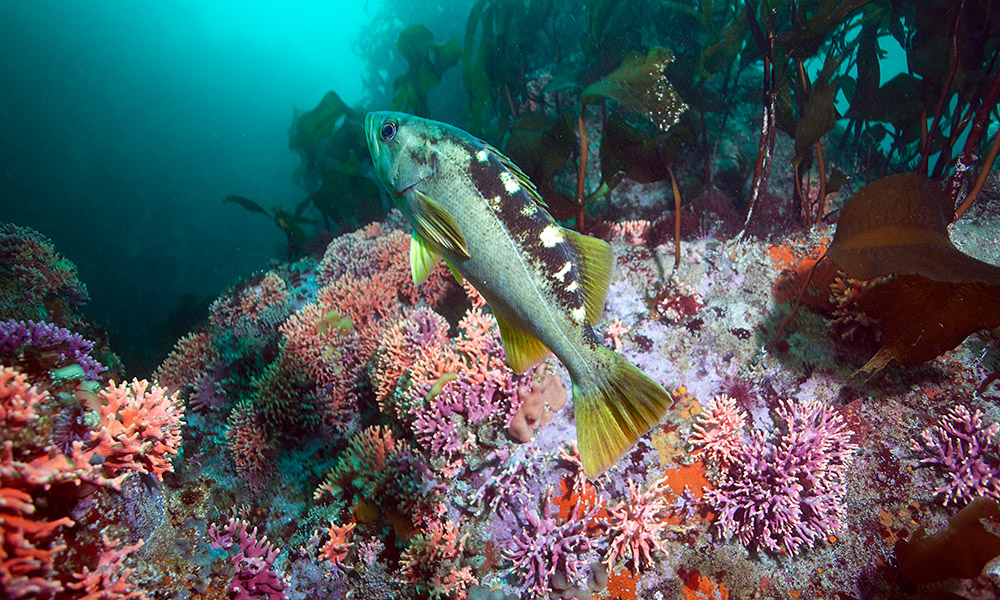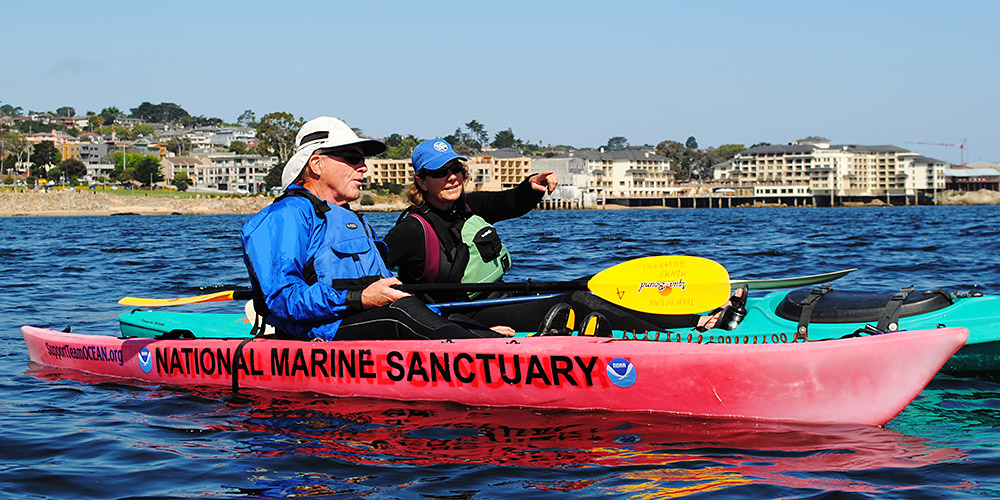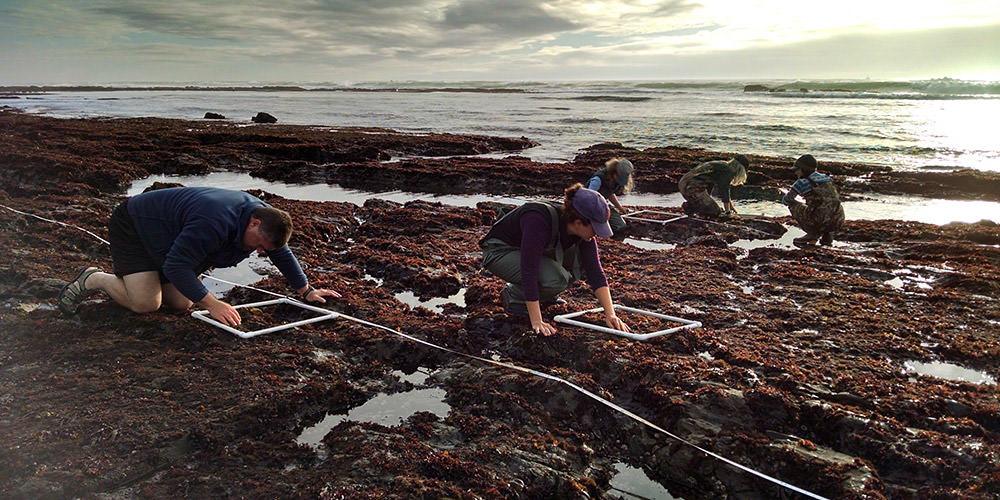Help Shape the Future: Monterey Bay National Marine Sanctuary releases draft management plan
By Elizabeth Weinberg
July 2020
Just off the coast of California lies one of the most bountiful, biodiverse areas of our ocean – Monterey Bay, also known as the "Serengeti of the Sea. Monterey Bay National Marine Sanctuary exists to protect the varied habitats and species of this ocean wonder. This month, NOAA is releasing a draft plan to update management objectives, activities, and regulations within the sanctuary, and is asking for public input.
"We are excited to reach this important milestone in the management plan review process when we ask the public for feedback, says Monterey Bay National Marine Sanctuary superintendent Paul Michel. "Staff, with input from the Sanctuary Advisory Council, have worked hard to develop a focused and strategic set of actions to improve the protection and understanding of this national marine treasure. We invite the public to weigh in on how this sanctuary is managed for years to come."
Serengeti of the Sea
Photo: Douglas Croft
Monterey Bay National Marine Sanctuary stretches along the California coastline from Marin to Cambria, protecting everything from surface waters to the seafloor more than two miles deep. Here, you'll find extensive kelp forests, a vast underwater canyon, rugged tide pools, tranquil estuaries, and a large offshore seamount.
These habitats harbor an incredible variety of animals. Some 36 species of marine mammals live in or pass through the sanctuary, including orcas, harbor seals, humpback whales, and Risso's dolphins. More than 180 species of seabirds and shorebirds can be found in the sanctuary, and at least 525 species of fish have been documented. The sanctuary is a hotspot for wildlife watching, kayaking, diving, surfing, and more.
The sanctuary was designated by Congress in 1992, after 10 years of public community support. It ensures that the habitats and animals of Monterey Bay will be preserved for current and future generations, while also supporting compatible public uses, like recreation and commercial fishing. The sanctuary is guided by its management plan. However, the management plan was last revised in 2008, and since then new challenges and opportunities have arisen.
Adapting to a Changing Ocean
Photo: Sam Bailey
Our ocean is undergoing significant changes. In recent decades, Monterey Bay National Marine Sanctuary has faced increasing pressures from marine debris, vessel traffic, coastal development, harmful algal blooms, introduced species, climate change, wildlife disturbance, and more. While the 2008 management plan enabled the sanctuary to respond to many of these threats, continued changes will require continual and ongoing adaptation. That's where the new proposed plan comes in.
Monterey Bay National Marine Sanctuary was formed as a result of community support and action, and the proposed plan carries on this tradition. Over the past several years the sanctuary has held 28 public meetings and accepted comments online and by mail, and has worked with its Sanctuary Advisory Council, user groups, agencies, and enforcement groups to shape the proposal.
The proposal contains three draft documents: a management plan, an environmental assessment, and a proposed rule. The management plan describes strategies and action plans for future conservation and management of the sanctuary, supplemented by information in the environmental assessment. Action plans focus on climate change, coastal erosion and sediment management, Davidson Seamount research and protection, emerging issue response, introduced species, marine debris, water quality, and wildlife disturbance. The management plan also provides guidance for education and outreach activities, maritime heritage, resource protection, research, and facility operations.
The proposed rule includes four modifications to existing regulations that will support more efficient and effective management while enhancing the protection of Monterey Bay National Marine Sanctuary. First, it would clarify that the beneficial use of clean and suitable dredged material is permitted for habitat restoration purposes. Second, it would modify regulations for the Mavericks operating zone near Half Moon Bay to potentially increase the number of days motorized personal watercraft could access the area. Third, it would modify regulations to motorized personal watercraft year-round zones for safety. And finally, it would correct an error omitting a list of Department of Defense-exempted activities in the 2008 environmental impact statement.
A Sanctuary for the Community
Photo: Douglas Croft
Monterey Bay National Marine Sanctuary is a community hub. The health of these ocean ecosystems is a driver for the local economy, and the region is a treasured resource for science, education, recreation, and more. It is a sanctuary for the community, and we want to hear from you.
Members of the public can provide input on any aspect of the proposal during a 60-day public comment period, ending September 4, 2020. Comments may be submitted online, by mail, or during virtual meetings scheduled for July 23, August 21, and August 24. The draft documents may be viewed on Monterey Bay National Marine Sanctuary website: montereybay.noaa.gov.
Comments can be made virtually, during three virtual public comment opportunities:
Date: July 23, 2020 during the Virtual Public Meeting
Time: 6:00 PM - 8:00 PM PDT
Register in advance at: https://attendee.gotowebinar.com/register/398908723113760523
- After registering, you will receive a confirmation email containing information about joining the webinar.
- If you are unable to participate online, you can connect to the meeting by phone using (415) 930-5321 and the attendee access code 811-630-048. If you will be participating by phone only and plan to provide public comment during the meeting, please send an email to mbnmsmanagementplan@noaa.gov to add your name to the speaker list.
Date: August 21, 2020 during the Monterey Bay National Marine Sanctuary Advisory Council Meeting
Public comment begins at approximately 12:30 PM PDT
Register in advance at: https://attendee.gotowebinar.com/register/3876637613490216459
- After registering, you will receive a confirmation email containing information about joining the webinar.
- If you are unable to participate online, you can connect to the meeting by phone using (415) 930-5321 and the attendee access code 811-630-048. If you will be participating by phone only and plan to provide public comment during the meeting, please send an email to mbnmsmanagementplan@noaa.gov to add your name to the speaker list.
Date: August 24, 2020 during the Greater Farallones National Marine Sanctuary Advisory Council Meeting
Public comment begins at approximately 11 AM PDT
Meeting link: meet.google.com/tyr-enfp-cet
- If you will be attending by phone only, please send an email to mbnmsmanagementplan@noaa.gov to add your name and join the meeting by phone using (641) 812-2321 and the attendee access code 135 736 466#.
- If you plan to provide public comment during the meeting, please send an email to mbnmsmanagementplan@noaa.gov to add your name to the speaker list.
- With the exception of the public comment portion of the meeting, the virtual sanctuary advisory council meeting will be audio recorded for the purposes of accurately developing meeting minutes. All public comments received, including any associated names, will be captured and included in the written meeting minutes, will be public, and will be maintained by the Office of National Marine Sanctuaries as part of its administrative record.
If you will be participating by phone only, please send an email to mbnmsmanagementplan@noaa.gov to add your name to the speaker list.
We also welcome comments online or by mail. Comment online via regulations.gov. Enter docket number NOAA-NOS-2020-0094, click the "Comment Now!" icon, complete the required fields, and enter or attach your comments
Comments can be mailed to:
Public Comment
Monterey Bay National Marine Sanctuary
99 Pacific Street, Building 455
Monterey, CA 93940
"Public input is vital to improving policies for dealing with important issues" in Monterey Bay National Marine Sanctuary and the surrounding communities, says P.J. Webb, Sanctuary Advisory Council vice chair. "Impacts from tourism and recreation, sea level rise and coastal erosion, wildlife harassment, and water quality are among the issues that my neighbors have shared. Now is the time for you to participate by sharing your ideas. Public participation is empowering and a vital part of our democratic governance.
Comment now to help decide the future of Monterey Bay National Marine Sanctuary.
Elizabeth Weinberg was the digital outreach coordinator and writer for NOAA's Office of National Marine Sanctuaries.





